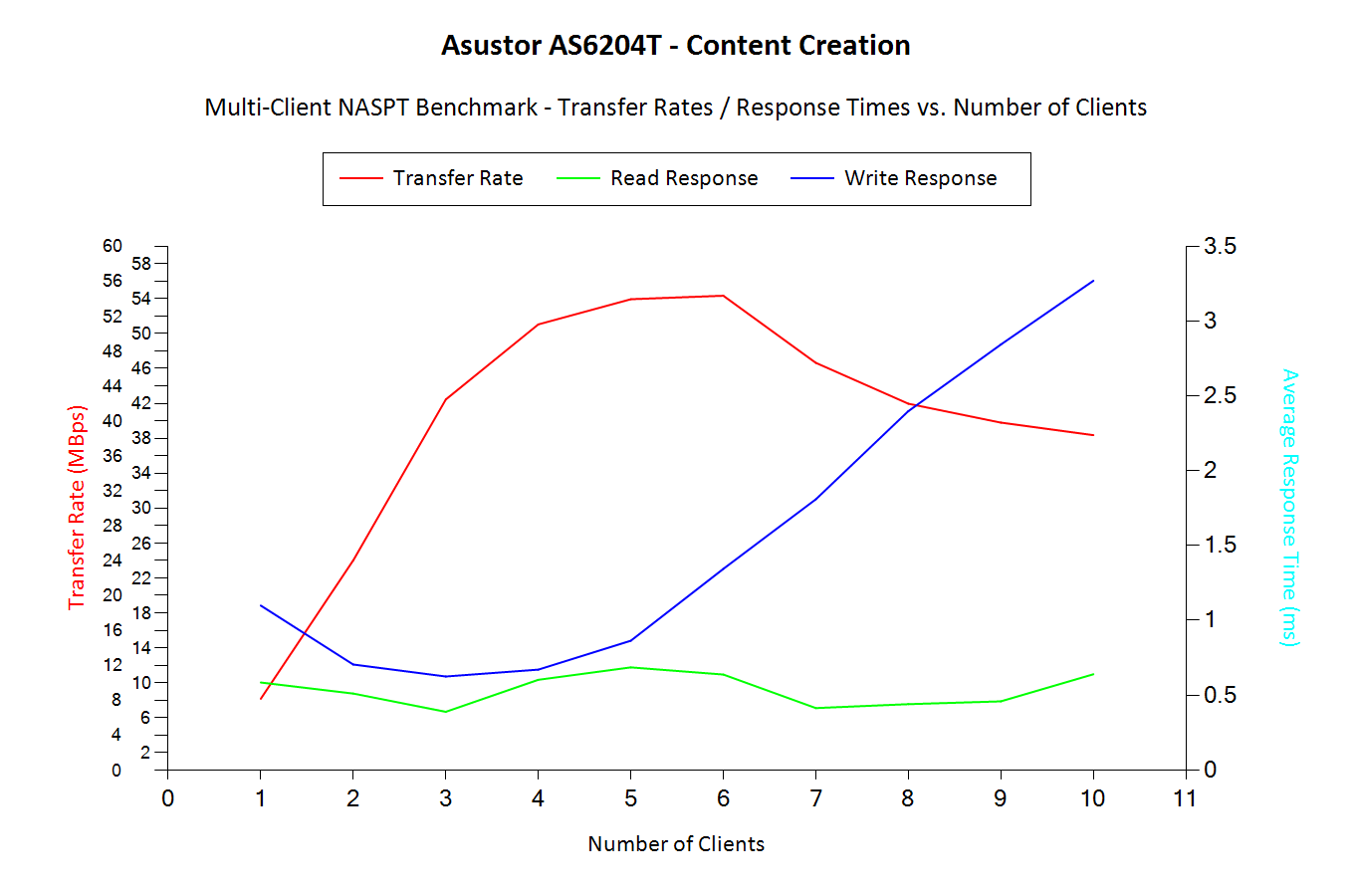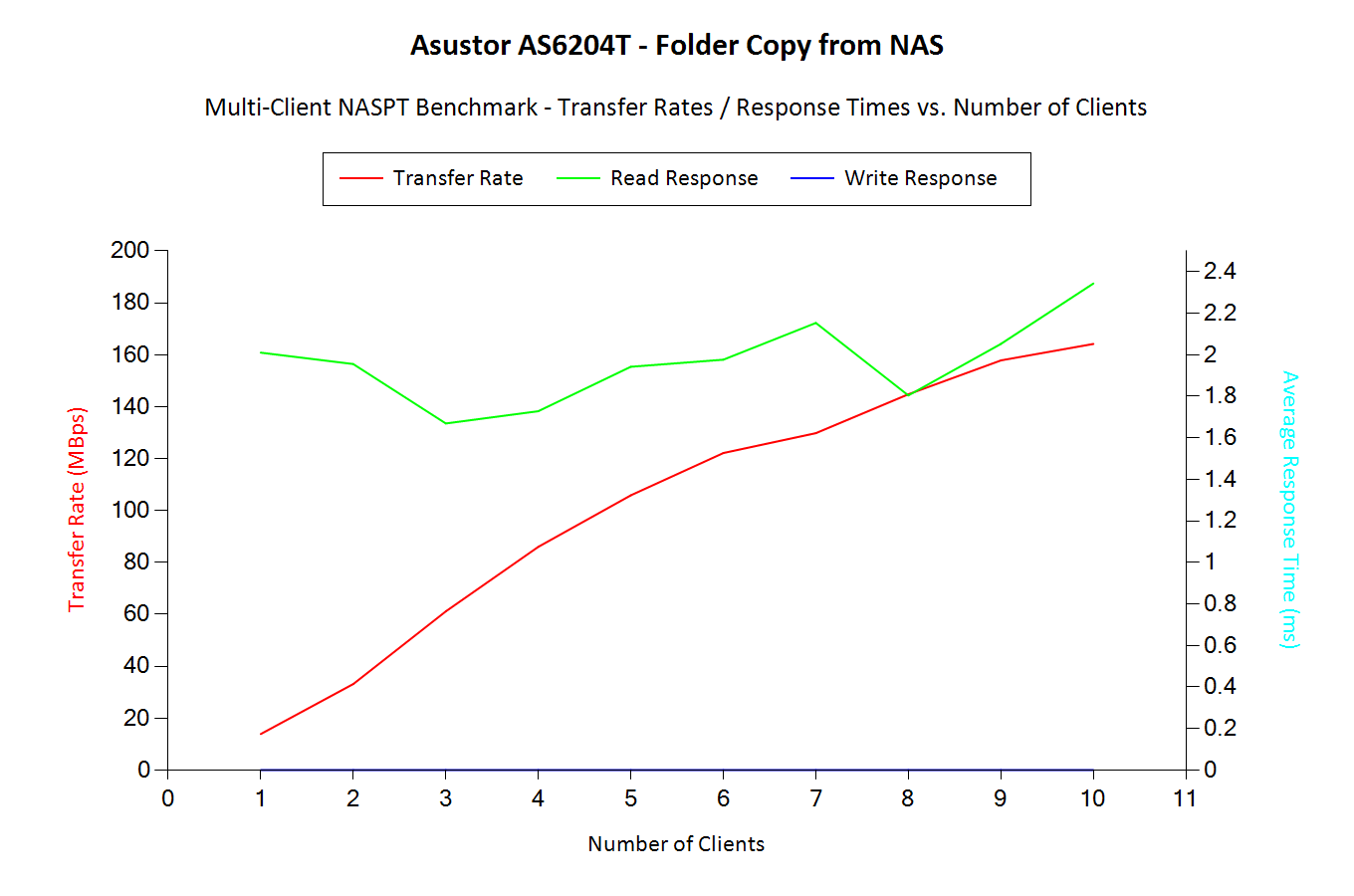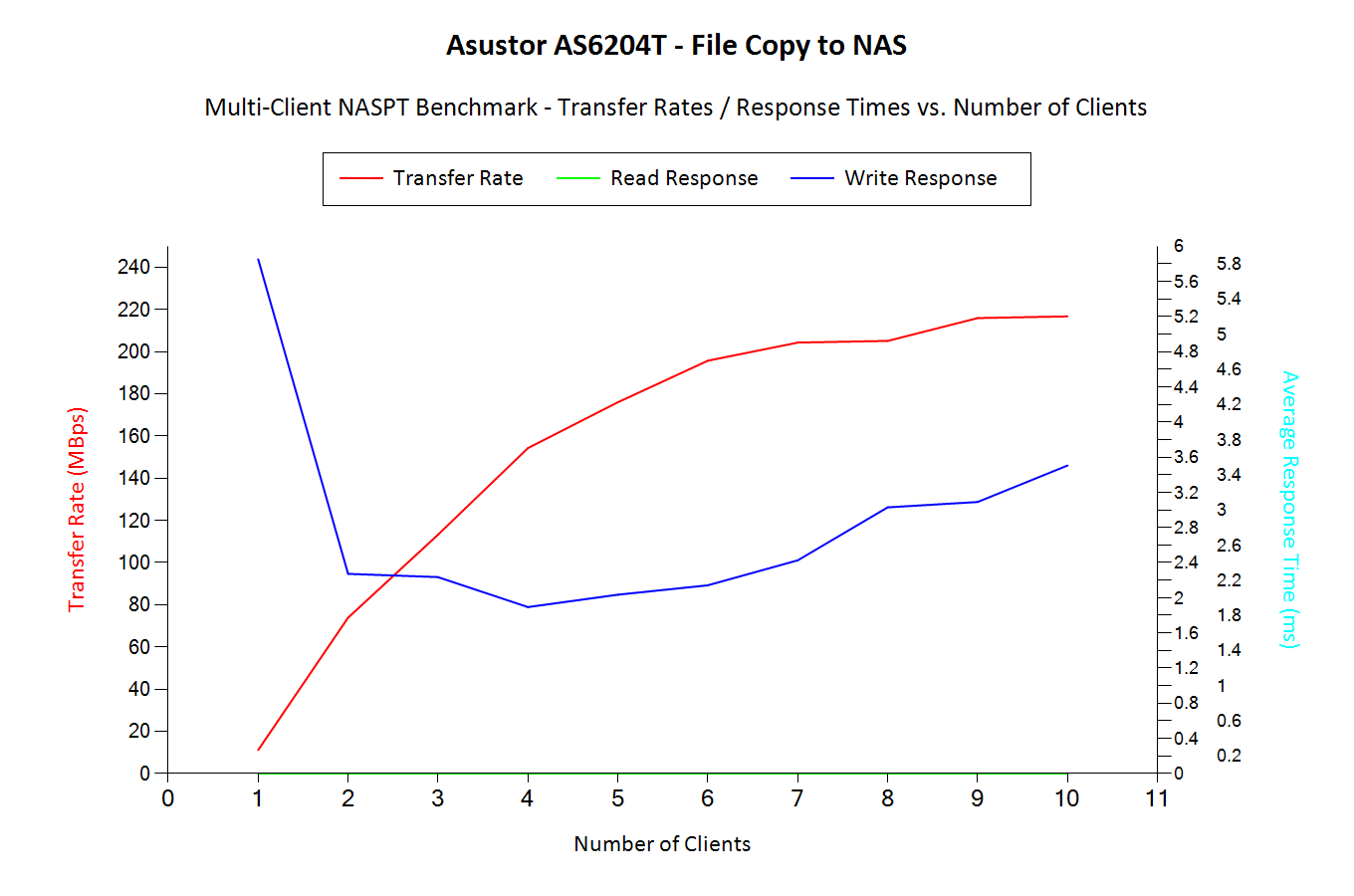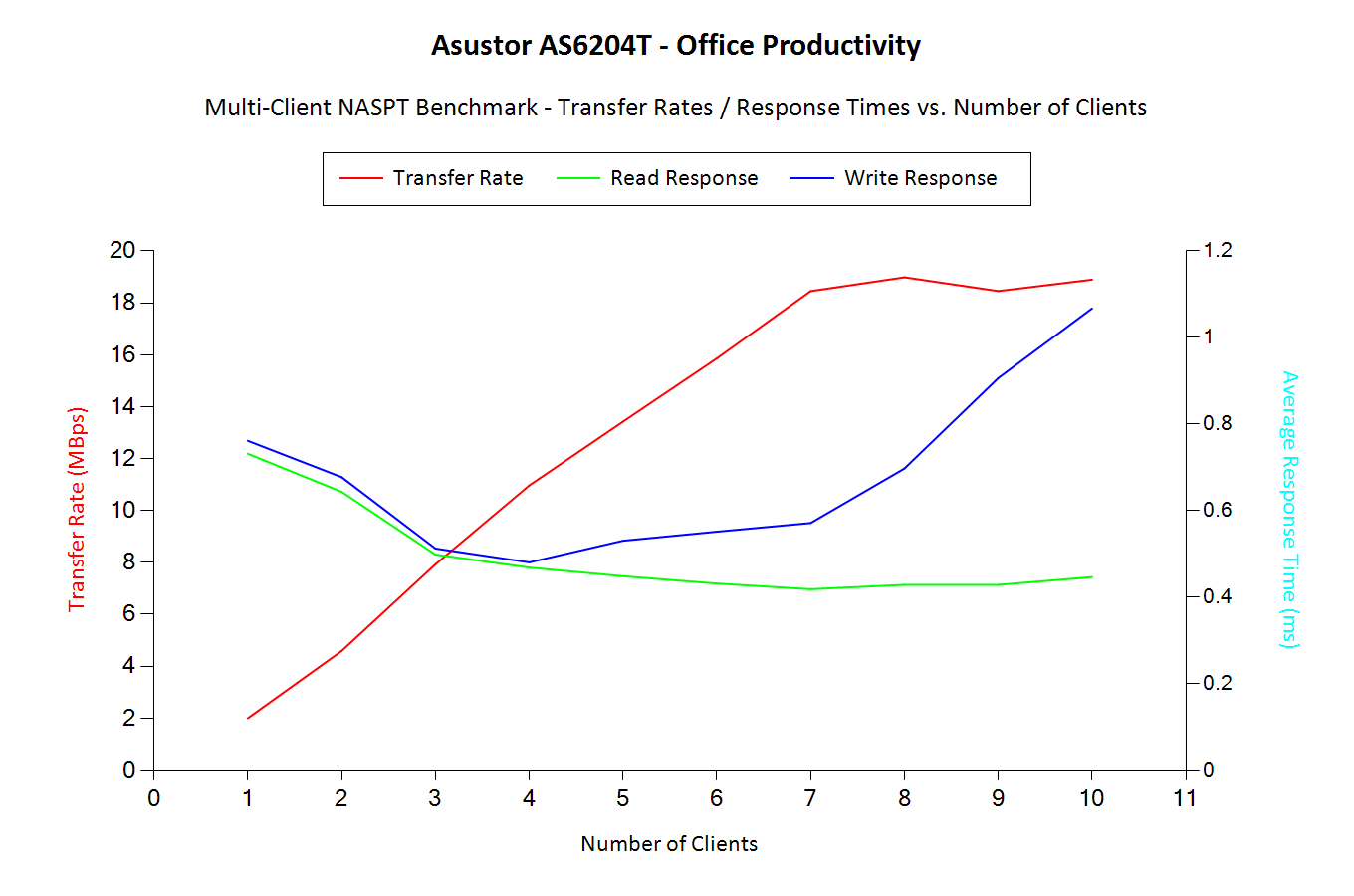Asustor AS6204T Braswell NAS Review
by Ganesh T S on November 5, 2015 8:00 AM ESTMulti-Client CIFS Performance for Consumer Workloads
The workloads experienced by a NAS unit in a typical home consumer setting have changed quite a bit over the last few years. Multiple mobile devices in a typical household raise the possibility that a NAS could be subject to the streaming out of multiple video files simultaneously. The popularity of IP cameras also make it necessary for NAS units to be able to record multiple video streams at the same time.
In our previous NAS reviews, we evaluated multi-client scenarios using synthetic workload traces and IOMeter. While there is nothing wrong in presenting numbers from such benchmarks, the reader is often left confused as to what those numbers might mean for his particular use-cases. Intel's NASPT benchmarking program gives us a good idea of the performance of the NAS unit when accessed by a single client. We took the source code of Intel's NASPT along with the supplied application traces and tweaked them to be able to run from more than one Windows client simultaneously in a co-ordinated manner. The graphs below present the results from tracking various metrics during the course of the benchmark runs. It must be noted that the average service times refer to what is obtained for all the traces when some of the data has already been cached in the client's memory. Unfortunately, NASPT doesn't provide any sort of guideline on what the optimal bandwidth and service times are for a good user experience.
Content Creation
The Content Creation workload seems to get acceptable performance for up to 5 clients. Beyond that, the per-client bandwidth numbers start to plateau / get worse, and the average response time also starts ramping up steeply. The drop-down at the bottom of the graph shows other comparison points. We find that the QNAP TS-451+ can support an additional client and provide better per-client bandwidth for the same workload. The detailed table with a breakdown of all the throughput numbers as well as the service times is available here

Folder Copy from NAS
The Folder Copy from NAS workload seems to get acceptable performance across the maximum number of clients that we tested (10). In this workload, we actually see that the AS6204T can perform better than the QNAP TS-451+. The detailed table with a breakdown of all the throughput numbers as well as the service times is available here

Folder Copy to NAS
The Folder Copy to NAS workload seems to get acceptable performance for up to 7 clients. Beyond that, we have a steep spike in the average response time. The QNAP TS-451+ performs better in this write-intensive workload. The detailed table with a breakdown of all the throughput numbers as well as the service times is available here

File Copy from NAS
The File Copy from NAS workload doesn't trouble the AS6204T. It gets acceptable performance across all tested clients (10). Unlike the QNAP TS-451+, the AS6204T is able to almost saturate the dual GbE links in this read-intensive workload. The detailed table with a breakdown of all the throughput numbers as well as the service times is available here

File Copy to NAS
The File Copy to NAS workload doesn't pose any problems to the AS6204T across the maximum number of clients we tested (10). The performance is actually neck-and-neck with the QNAP TS-451+ as we increase the number of clients. The detailed table with a breakdown of all the throughput numbers as well as the service times is available here

HD Video (1x) Playback
The HD Video (1x) Playback workload is read-intensive, and, as we have seen from previous workloads, the AS6204T is able to easily surpass the QNAP TS-451+ both in terms of nett bandwidth as well as lower average response times. In fact, a little bit of caching on the clients side actually enables apparent saturation of the network links. The detailed table with a breakdown of all the throughput numbers as well as the service times is available here
-Playback.png)
HD Video(1x) Playback and Record
The HD Video(1x) Playback and Record workload involves both reads and writes. The full-duplex nature of the network links enables the total bandwidth to be more than 300 MBps for this workload. Performance is better than the QNAP TS-451+ across all metrics for this workload. The detailed table with a breakdown of all the throughput numbers as well as the service times is available here
-Playback-and-Record.png)
HD Video (1x) Record
The HD Video (1x) Record workload fares similarly in both the AS6204T and the QNAP TS-451+. This write-intensive workload comes close to saturating the network links for both systems. The detailed table with a breakdown of all the throughput numbers as well as the service times is available here
-Record.png)
HD Video (2x) Playback
The HD Video (2x) Playback workload pulls the AS6204T ahead of the QNAP TS-451+ as the number of read streams increases. The network links are close to saturation in the Asustor case. The detailed table with a breakdown of all the throughput numbers as well as the service times is available here
-Playback.png)
HD Video (4x) Playback
The HD Video (4x) Playback workload behaves similar to the 2x playback workload. The AS6204T performs better than the QNAP TS-451+ in this case. The detailed table with a breakdown of all the throughput numbers as well as the service times is available here
-Playback.png)
Office Productivity
The Office Productivity workload seems to get acceptable performance for up to 7 clients. Beyond that, we have a noticeable drop in the per-client bandwidth numbers and a ramp in the response times. The QNAP TS-451+ is able to easily surpass the AS6204T in this IOPS intensive workload. The detailed table with a breakdown of all the throughput numbers as well as the service times is available here

Photo Album
The Photo Album workload seems to get similar performance for both the AS6204T as well as the QNAP TS-451+. All 10 clients seem to get acceptable performance. However, the average write response times for the AS6204T are a bit higher compared to the QNAP TS-451+. The detailed table with a breakdown of all the throughput numbers as well as the service times is available here

The detailed logs from the processing of our benchmarks - inclusive of metrics such as the file open times for each workload on each of the clients - can be found here










29 Comments
View All Comments
Der2 - Thursday, November 5, 2015 - link
Nas life.zeeBomb - Thursday, November 5, 2015 - link
I have heard a lot about these surverlliance stations for quite some time now...appears to be the next big thing. Thank YOU for delivering these results!asendra - Thursday, November 5, 2015 - link
I'm hoping Sinology releases in 2016 a 4bay braswell NAS, a DS416+ if you will, hopefully with a N3700. They have already announced some 2016 models with braswell, just not the ones I want.I would buy the current DS415+, but because I'm in no need of one right now, I just hope they get to it before I need to make the purchase.
galfert - Thursday, November 5, 2015 - link
I think the DS716+ is the device to get this year. No need to wait for a DS416+. If you need more than two drives you can get the 5 bay expansion model for the DS716+. That is why it is called a DS7xx+ model...because you can have 7 drives. So it is better than a DS4xx model which can't support the expansion module.For me the DS716+ is the device I've been waiting for. Powerful Intel CPU, Expandable RAM, Expansion module support, Transcoding of video, virtualization support, Hardware Encryption support. It has everything I need. Previously you had to compromize. I have a DS214play and a DS713+ and the DS716+ can replace both of them.
asendra - Friday, November 6, 2015 - link
You know, I hadn't considered that option. It would be a more expensive one, but it could work, in fact I could use a dx213 instead, wich gives me plenty storage for my needs.If when I need to buy one this next year they haven't released yet the new 4bay braswell ones, I might go with this option instead of the older ds415+.
Another thing I wanted to wait for so I could see how it develops It's Btrfs support.
DanNeely - Thursday, November 5, 2015 - link
Is the rebuild time graph showing numbers in seconds? Hours would be a lot more immediately meaningful. /3600 isn't a particularly easy mental computation.romrunning - Thursday, November 5, 2015 - link
Your article says: "Their Braswell lineup consists of four models, with each model name following the pattern AS6X0YT, where X (1 or 2) refers to the number of cores in the Braswell SoC in the model and Y (2 or 4) refers to the number of bays."Yet the Asustor AS6204T has 4 cores. So by your definition, it should have been named the "AS6404T".
So it sounds like your definition should be updated.
romrunning - Thursday, November 5, 2015 - link
Forget the above - the wording isn't as clear. I thought you were saying it was a direct relationship where the number = amount of cores. It could have been written that the second numeral denotes whether the CPU is dual-core (X=1) or quad-core (X=2).romrunning - Thursday, November 5, 2015 - link
This also reminds me - with today's advanced CMS/commenting systems, why can't we edit or delete our own comments on Anandtech??DanNeely - Thursday, November 5, 2015 - link
Which editor/reviewer do you want to furlough to hire a web developer to replace the comment system?